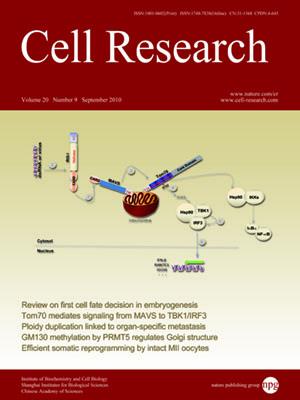
Volume 20, No 9, Sep 2010
ISSN: 1001-0602
EISSN: 1748-7838 2018
impact factor 17.848*
(Clarivate Analytics, 2019)
Volume 20 Issue 9, September 2010: 1043-1059
ORIGINAL ARTICLES
Metamorphosis of the malaria parasite in the liver is associated with organelle clearance
Bamini Jayabalasingham, Nazneen Bano and Isabelle Coppens
Department of Molecular Microbiology and Immunology, Johns Hopkins Bloomberg School of Public Health, 615 N. Wolfe Street, Baltimore, MD 21205, USA
Correspondence: Isabelle Coppens,(icoppens@jhsph.edu)
Malaria parasites encounter diverse conditions as they cycle between their vertebrate host and mosquito vector. Within these distinct environments, the parasite undergoes drastic transformations, changing both its morphology and metabolism. Plasmodium species that infect mammals must first take up residence in the liver before initiating red blood cell infection. Following penetration into hepatocytes, the parasite converts from an invasion-competent, motile, elongated sporozoite to a metabolically active, round trophozoite. Relatively little is known about the cellular events involved in sporozoite metamorphosis. Our data uncover the early cellular events associated with these transformations. We illustrate that the beginning of metamorphosis is marked by the disruption of the membrane cytoskeleton beneath the plasma membrane, which results in a protruding area around the nucleus. As this bulbous region expands, the two distal ends of the sporozoite gradually retract and disappear, leading to cell sphericalization. This shape change is associated with major interior renovations and clearance of superfluous organelles, e.g. micronemes involved in invasion. The membrane cytoskeleton is reorganized into dense lamellar arrays within the cytoplasm and is partially expulsed by converting parasites. Simultaneously, micronemes are compartmentalized into large exocytic vesicles and are then discharged into the environment. At the completion of metamorphosis, the parasites only retain organelles necessary for replication. These observations lay the groundwork for further investigations on the developmental pathways implicated in the metamorphosis of the malaria parasite.
Cell Research (2010) 20:1043-1059. doi: 10.1038/cr.2010.88; published online 22 June 2010
FULL TEXT | PDF
Browse 2300


